Indian Elections 2019: Towards New Economic and Political Goals
Supporters of India's Prime Minister Narendra Modi await his arrival during a roadshow in Varanasi, India, April 25, 2019
(votes: 4, rating: 4.75) |
(4 votes) |
Assistant Professor of International Relations and Strategic Studies, at the Department of International Relations, Goa University
The current protracted election campaign has been enduringly characterized, by a lingering overhang of foreign policy and national security considerations, punctuated by constant reminders of India’s rising acclaim on the world stage and resonation for its touchstone issue of epochal significance (counter-terrorism). Indian diplomatic and capacitive footprint would be deployed, to address the sub-continent’s structural socio-economic impediments and physical capacitation concerns, as a substantive antidote to the invariably operating existential security paradox of fragile states and porous borders. The presumably second Modi administration will have to deal with the scenario in Afghanistan, characterized by the engendering conditions for an American troop withdrawal from the country, the formulation of contours for potential rehabilitation of the Taliban within a prospective Afghan political future and the fomenting US-Iran crisis in the Middle East. The Iran dossier presents Indian foreign policy with a cleft-stick specter, wedging dilemmas and straddling angularities. One could not greater underscore the importance of Tehran for New Delhi, not just from the lens of longstanding energy is driven equations, but from the prism of the criticality of its multi-modal access to the far reaches of the Central Asian and Eurasian continental swathe. The second Modi regime would be under scrutiny for how this foundational economic diplomacy is consolidated and elevated into a new orbit, at a time when the government has pledged to catapult the nation to a five-trillion-dollar economy within a decade. The ensuing epoch in Indian foreign policy would be a build-on phase, under the philosophical and operative moorings of a ‘continuum-neighborhood’ concept, which draws on immutable features of India’s geographical physiology and the attributive tenets of its civilizational span, to construe meaningful engagements in its Eastern and Western vectors.
As the world’s most mammoth democratic exercise at the hustings successfully winds down on another electoral cycle and the intuitive feel and considered wisdom posits plain-sailing return to helms hip for the incumbent BJP-led National Democratic Alliance (NDA) coalition, the anticipated focus appears to be plausibly shifting, towards decoding the prospective strategic-priorities and attendant policy-parameters, that would constitute and chaperone foreign policy and national security, under a Modi strategic calculus 2.0. (At the time of penning this account, India had not tallied, its federal election results).
The features of the electoral campaign
Unless in the grips of existentialism, national security and foreign policy dimensions rarely figure on the campaign-stump in India, or for that matter across most celebrated and mature democracies. This being said, the current protracted election campaign has been enduringly characterized, by a lingering overhang of foreign policy and national security considerations, punctuated by constant reminders of India’s rising acclaim on the world stage and resonation for its touchstone issue of epochal significance (counter-terrorism). The expected narrative of the ruling coalition trenchantly prosecuting the virtues of continuity versus the pyrrhic costs of change and the medley of opposition parties desperately litigating the need for the electorate to embrace their case for change. The election has been conducted in the shadow of India’s punitive cross-border air-strikes into Pakistan, presenting itself as arguably swift comeuppance for the terror assault in Jammu Kashmir state and evidence of emphatic decisive leadership of the Prime Minister to glower at and not be cowered, by the scourge of terrorism emanating from across its North Western border. The terror attacks in Sri Lanka helped coalesce popular opinion within India on the urgent imperative to choose the establishment, which can confront this metastasizing phenomenon and not favor the one which would equivocate on the issue. Then, the rare occurrence of the United Nations Security Council unite in unanimity, in placing the regional terrorist mastermind Masood Azhar, under global sanctions regime proscription, after Chinese relent over its technical-hold, allowed for the peddling of spin that speaks to visible evidence of persuasive traction for quiet, but purposeful Indian diplomatic manoeuvres, under Prime Minister Modi’s leadership. (After all, Indian diplomacy has worked to bring international opinion around this issue, since 2009, but with little success until recent moves). Besides, as elections unfolded, the news of the Prime Minister being feted with highest civilian honors, first from Russia and latest by the UAE, for coveted contribution to the development of bilateral ties, served as effectively oriented the outcome of Indian foreign policy were pursued these past five years. Hence, it was no surprise that throughout the campaign, these accomplishments were used as evolving signposts of a globally practiced foreign policy forged on a wider elemental and dimensional canvass.
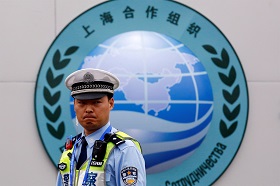
BRICS, SCO and Kashmir Terrorism
India’s engagement in its neighborhood
The neighborhood surrounding India remains a challenged and contested geopolitical area, which would understandably attract the attention of the new government, mirroring the impulse from the onset of the Modi premiership back in May 2014. Consequently, the incoming Prime Minister pulled a diplomatic fast-one, by inviting all South Asian regional leaders, carrying out its strong sense of instructiveness. Such a move encapsulated an interplay of trinity messaging to stakeholders, showing its disproportionately outsized role in consensually shaping the region-on-the-move towards productive beneficence. This Indian diplomatic and capacitive footprint would be deployed, to address the sub-continent’s structural socio-economic impediments and physical capacitation concerns, as a substantive antidote to the invariably operating existential security paradox of fragile states and porous borders. Also, the region and all of its sovereign constituents would be subject to the inviolable redline of scrupulous good neighborliness, that would certainly require reciprocity though not necessarily parity in action, meaning the preclusion of their territories from being leveraged for inimical actions against itself. Through enhancing the profile of Indian engagement of its contiguous and proximate partners, wide assiduous politico-diplomatic engagement, it would be seen in the higher incidence of echelon visits (Modi sojourned to all South Asian countries during his full term in office) and revving-up of institutional mechanisms for bilateral dialogue. The Indian approach in South Asia over the past five years has witnessed a conscious effort to recoup ceded strategic space and to induce centrality back to New Delhi’s.
Moreover, the key to underpin the tectonic pan-South Asian economic transformation and mobility would be the following methods: a conscious coordinated endeavor from the highest reaches in government, a streamline tardy and slothful cross-country infrastructural projects towards expedited completion in winning back eroded credence of commitment, and entrenching the imperative notion of multi-vectored connectivity, along logistical compact, commercial interchange and civilizational affinities. However, it might be hard for New Delhi to diminish South Asian countries’ trade dependence upon China and to shrug-off the increasingly indomitable buccaneering industrial and infrastructural footprint of Beijing across Himalayan and Maritime South Asia, which constitutes the former’s proverbial sphere of influence. This is the reason why, the new administration has to embrace a strategy of counterpoise, blending elements of outright reductionist retaliation in certain coordinates, with the sophisticated and nuanced operation of a qualitatively differentiated paradigm at shaping the region in the piloting of newly minted and revived functional initiatives at regional economic cooperation (BIMSTEC), and models of mini-lateral integration (BBIN), etc., to build greater heft in the vicinity.
The presumably second Modi administration will have to deal with the scenario in Afghanistan, characterized by the engendering conditions for an American troop withdrawal from the country, the formulation of contours for potential rehabilitation of the Taliban within a prospective Afghan political future and the fomenting US-Iran crisis in the Middle East. Furthermore, the new administration will have to manage the American diktat to Iranian oil consumers, such as India, to shutter sourcing which exerts a collateral undermining impact on Indian strategic interests Their outcomes could undercut Indian stakes and valid expectations for exercising its influence in the region. These issues become further critical from an Indian standpoint, as their propitious resolution holds the sluice-gate keys to New Delhi’s tangible profile in engagement of Central Asia for strategic resources and as avenues for markets, both of which are contingent on a democratically benign, secure and stable Afghanistan. Concerning Iran, it is not subject to straitjacketed coercion from its arch-rivals within the region and the US on the extent, that would dis-incentivize its amenable disposition towards initiatives at regionally multi-lateralised economic cooperation and advancing objectives for share the access. These two issues are expected to figure in principal discussions at the impending SCO Summit in Kyrgyzstan, in June. In the meanwhile, since no potential solutions are to be forthcoming, it would put at a premium the Indian quest since 2012 and since Prime Minister Modi’s maiden visit to all the CARs in 2015 and India’s incorporation into the SCO in 2017, for cultivating cogent and enlightened bilateral exchanges with each of the region’s sovereign constituents.
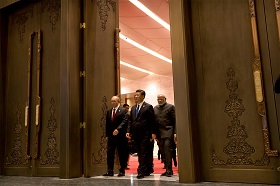
Indo-Pacific or Community of Common Destiny?
Regarding Afghanistan, while the US has kept India abreast on the trajectory of its Qatar based backchannel with the Taliban, New Delhi fully sentient of Washington’s longing for terminating its inordinately lingering military involvement, which made it anxious, due to the apparent lack of clarity of Washington’s redlines and the latter’s ambivalence over Taliban’s incorporation into an Afghan government, without eliciting adequate accountability and a sufficing abjuration of violence. As a significant developmental partner for Afghanistan, with the involvement of fisc and material resources across a wide spectrum of capacity building projects, only second to Washington, New Delhi expects to be actively shaping the progression to a democratic, secure and stable Afghanistan. Henceforth, aware of the fluidity of the situation and mindful of the steadily expanding role of Russia and China in exploiting the pristine diplomatic space in Afghanistan, and how it could potentially resurrect Islamabad’s mission ‘strategic-depth’ in Kabul through the backdoor, it has precipitated into an enlightened New Delhi tactical approach, through shedding some of the idealism that has traditionally pervaded Indian strategic thinking in favor of participating in the Russian spearheaded Six-Party Dialogue Framework, even to sit at the Moscow table alongside Taliban interlocutors. In addition, it has worked with the US establishment principals at the State Department and the Pentagon, on calibrating a convergent and harmonizing approach, whilst niftily tiptoeing around the occasional rants of an irascible US President, taking derisive swipes at India’s developmental compact with Afghanistan, and its considered and principled reluctance, to not burden-partake through commissioning of a supplanting military presence in Afghanistan.
The Iranian question
The Iran dossier presents Indian foreign policy with a cleft-stick specter, wedging dilemmas and straddling angularities. One could not greater underscore the importance of Tehran for New Delhi, not just from the lens of longstanding energy is driven equations, but from the prism of the criticality of its multi-modal access to the far reaches of the Central Asian and Eurasian continental swathe. Also, Iran could be the maritime leverage in the Western Indian Ocean, where India manages port infrastructures and logistics arrangements, constituting vital instruments for strategic influence, commercial and mercantilist traction, along strategic sea lanes of communication. If US policy forces principal oil buyers, such as India, to totally blank oil purchases from Iran, (moreover, the chances seem remote as long as Trump helms affairs), then the potential forsaking of Iran from India allows peer competitor China to exploit the situation and trigger an Iranian tilt to its side, in pursuance of Beijing’s tangible offers of Iranian incorporation within the infrastructural ambit of the robustly fording Belt and Road Initiative (BRI). The Iran portfolio also brings to the fore, the debate about what exactly is strategic autonomy in foreign policy, and how does it pan out. Among the animated dynamic setting of an interconnected and interdependent world, it is most understood and internalized that trade-offs and quid pro quos undergird transactional interchange occur. Under a Modi premiership, Indian foreign policy has managed the enviable reputation for dexterously navigating through regionally adversarial juxtapositions, not through defensive self-preservation or abstinence of the past, but through proactively cultivated productively beneficent relationships, with a Jewish Israel, Shia Iran and the Saudi tutelage the Sunni Gulf States. However, this largesse may just have run its course, hopefully momentarily, as New Delhi might well perceive circumscribed downsides to its downgrading of commercial exchanges with Iran, as hydrocarbons deficits could be bridged through realigning shipments from Saudi Arabia and the UAE. Besides riling up a strategically blinded non-countenancing and punitively oriented Washington won’t be desirable.
The second Modi regime and the prospects of new economic diplomacy
Historically, Indian foreign policy trajectory, and strategic orientation, in the post-liberalization period, has suffered from a triumvirate of infirmities, which have rendered its external outreach and engagement hemmed, hobbled and hortative. The advent of the Modi administration in 2014 was refreshing in that, it delineated a new template for Indian internationalism and forged it in the dispensing with staid cartographic imaginations of our neighborhoods in favor of re-imagined carve-ups of conceptions of the near-abroad. In abandoning the self-deprecating sub-continental scale of our economic existence and subsistence in favor of a comprehensive re-envisioning of economic diplomacy, it anchored in the inherent dynamism of rule-based democratic governance and demographics of demand being pitched as an attractive global proposition, building societal affinities and synergies. The second Modi regime would be under scrutiny for how this foundational economic diplomacy is consolidated and elevated into a new orbit, at a time when the government has pledged to catapult the nation to a five-trillion-dollar economy within a decade. Thereby, it made robust international economic interaction and interchange, an indispensable sine qua non for accomplishing such an ambitious strategic objective, amidst global headwinds of recession and the rising tide of protectionism worldwide. Achieving this quantum-leap scale-up, in economic size and profile, would need more than just linear organic progression. During the last five years, India moved from being viewed as a country with the promise to deliver on its potential to a nation on the economic march, witnessed in the hue of tectonic reforms consummated domestically and investment initiatives envisioned and instrumentalized in addressing both hard and soft infrastructural deficits. India transitioned, to being globally acclaimed as the fast-growing emerging economy, besides dimensions of its internal economic and policy transformation finding enthused endorsement in international policy circles. This elevated economic performance and the cogency of politico-executive leadership of the day has allowed Indian diplomacy to turn sure-footed, vigorous and purposeful on the international stage. It also resulted in the participation of Prime Minister’s pitch on the major platform of international relations, such as 2014 G20 in Australia and the annual World Economic Forum conclave in Davos in 2018. Notwithstanding, Indian diplomacy is moving further it by committing to in the global agreement on Climate Change in Paris, and to the India-France co-sponsored International Solar Alliance (ISA) initiative, headquartered in India, which is aimed at promoting expanded use of renewable energy for sustainable development, across the sovereign-comity of the putative ‘Global South.’
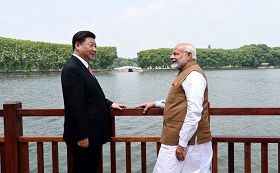
Heartland Reunion: Geopolitical Chimera or Historical Chance?
The ensuing epoch in Indian foreign policy would be a build-on phase, under the philosophical and operative moorings of a ‘continuum-neighborhood’ concept, which draws on immutable features of India’s geographical physiology and the attributive tenets of its civilizational span, to construe meaningful engagements in its Eastern and Western vectors. With India’s Eastern longitudinal stretch, both seaboard and inland, its position in the North-Eastern section and its obscuring black-hole, starved from rudimentary development, abutting South East Asia with one half of the Indian manufacturing GDP for exports. Besides the civilizational contacts, the process of fostering comprehensively intimating ties with the ASEAN comity of nations, as with other economic titans in East Asia, has been a signature initiative of the Modi government during 2014-2019, with no reason for it to flag or dampen. It ought to intensify across intertwining dimensions of augmented trading exchanges, deepened the development of multi-modal transportation infrastructure, enhanced integration of markets and logistics facilities, and greater investor-led stake-holding by these countries.
Similarly, with India’s ordained maritime location, residing astride strategic sea lanes of communication, the Modi government, during its first term, has embarked on a mission to impart situational sense to locational amenability, principally in the Indian Ocean Region (IOR), through the commissioning and execution of a slew of path-breaking projects and initiatives, which pioneered under the marquee nomenclature of ‘SAGAR’ (Security and Growth for All in the Region). With the IOR, it is incumbent upon the new Indian government, to sustain its alacrity and proactivity, by its quest for preserving the primacy of operation, insulation of its sea-borne commercial interests and safeguarding its strategic sphere of influence, even though not exclusionary or prejudicial to any extant entity refuses insubordination or supplication. The Modi government seeks to enhance India’s power profile in the immediate maritime stretch, which would allow it to serve as a covetable stabilizing influence, contributing in its role as a prime ‘swing-power’, maintaining symmetry and equilibrium between competing domineers and helping shape the normative, institutional and capacitive edifice of the wide ocean ‘Indo-Pacific’ space, away from singularized ascent and towards a shared commons.
What about the US, China, and Russia?
The greatest operative determinant to Indian foreign policy, as it seeks to carve-up prominent stock for itself within a rising Asia, is how it handles its coupled equations, with the strategic trifecta impinging on its external orientation with the United States, China, Russia, and Japan. The Indo-US relationship remains the predominant key to India’s national aspirations for autonomous development and accretion in power-profile and attendant power-projection, across Asia and on the world stage. However, there is no gainsaying, that despite the brimming potential of the relationship in bilateral and regional terms, it does intermittently constrain New Delhi’s strategic choices and does inflict collateral damage to Indian strategic interests. Despite the burgeoning levels of political affability, economic interaction and societal interface, US-India engagement finds itself meandering, in aspects of market-access based trade disputes, disagreements over certain technology transfer mechanisms and perceived inadequacy over regimes governing the protection of intellectual property and the interests of the knowledge-based services sector.
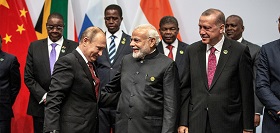
BRICS Should Avoid Becoming an anti-US Group
Moreover, notwithstanding the significant advances incrementally achieved in the mutual strategic partnership, most notably witnessed in iconic collaborative agreements inked, in high-end civilian, high-tech communication, and sensitive defense-cooperation and military-operability sectors, a mutual wariness permeates ties brought on by a perceptible gap in actual performance, falling short of expectation thresholds. While New Delhi feels let-down, that Washington does not adequately tighten the noose on Pakistan towards extracting substantive remedial action on terrorism spawning from Islamabad, the US reckons that New Delhi does not step-up its game enough to dispose more proactively in countering China across Asia, most notably, across the Indo-Pacific, where intriguingly the two sides are concurred on an ostensible Joint Vision formulation and articulation for the ocean-continuum. It is clear that Prime Minister Modi, in his second term would have his hands full, in continuing to deal with an overtly transactional and short-leashed temperamental US administration, having to keep his side of the grand partnership bargain, whilst not transgressing on inveterately held and well-deliberated red-lines. Even as his government works through the scope of US institutional labyrinth, both congressional and bureaucratic, towards tempering the incumbent President’s pushbacks on matters of bilateral concern.
This segues into an examination of Sino-Indian relations, which seems to have historical baggage and mutual chariness of each other’s strategic intentions, between two simultaneously rising continental powers, in relative proximity and regional contiguity of each other. with the concurrence of politically ascendant trajectories of two leaders with strong personalities and cult-like followings domestically, the relationship during the past five years, marked a roller-coaster ride, commencing with the hyped euphoria of significant Chinese investment-led economic cooperation, descending into a purportedly escalatory slide that verged on potentially miscalculated conflict. During this period, the apogee of the Doklam territorial standoff during 2017 led to mutual good sense and to a commitment to establish ties concerning the indeterminate border. Additionally, it signified an engagement in a candid, but constructive dialogue, to comprehend strategic intentions around broader aspects of the relationship, and how each other’s instrumentalities militate, in each other’s coterminous and overlapping realms of perceived and proven influence. While the informal setting of the Wuhan Summit of 2018 was meant to induce a reset in ties, notwithstanding the bonhomie and geniality that was manifest, it would be risky to consider the bedevilling issues stemming from Chinese imperviousness to strident Indian criticism over the sovereignty contravening China-Pakistan Economic Corridor (CPEC) component within the Belt and Road Initiative (BRI). The Chinese refusal to allow Indian candidature of NSG membership decoupled from that of Pakistan, that is viewed and regarded as deeply and qualitatively odious, by the latter, and the nature and tenor of Chinese investments across South Asia, which has India spooked on dimensions of being predatory through vitiation of the fiscal health of the smaller nations. China harbors have their own set of concerns, stemming from a stepped-up Indo-US compact and an India-US-Japan role for strategic maneuvering across the Indo-Pacific, and the reviving of the QUAD framework, described as a Concert of Democracies quadrant committed to ensuring the plurality of the Indo-Pacific, a veiled reference to work against Beijing. The challenge for both sides would be to ally each other’s concerns credibly and tangibly, which would entail political statesmanship, forthright exchange of views, but some craft in forging project cooperation, that can reduce the trust deficit, which in turn lies at the core of the mutually critical relationship steeped in chariness and hesitation.
The resurgent role of Russia on the world stage and it's robust inject into hotspots and flashpoints around the globe, allowing for a duality of views about its genuine intentions and how to respond to them, with the Indian establishment being no exception either in being called upon to re-appraise the once bell-weather relationship. Among perceptions about Moscow being a necessary strategic disruptor, contributing to balancing an otherwise US skewed global order, Prime Minister Modi has been pragmatic and principled in letting Indian national interests drive the Indo-Russian exchange, rather than be wedded to preconceived notions. The challenge on the bilateral track of reinventing the relationship beyond defence cooperation and a few lines of commercial interchange, notwithstanding the Modi government’s effort has been to forge new vistas of engagement on strategic dimensions of ramped-up energy cooperation, science and technological intermediation for civilian applications, innovation smitten joint-investments, in addition to the sophisticated and value-added co-development programs in modernised defence platforms, apart from the perfunctory phenomenon of defense hardware transactions. The fact of resilience in India-Russia engagement was tested and showed-up well, in the resoluteness of India’s acquisition of the Russian S-400 missile defense system, weathering repeated US prodding, nudges, and implicit threats of collaterally damaging implications.
Similarly, New Delhi’s recent reconsideration of long-held reticence at upgrading the level of the mundanely operating Russia-India-China (RIC) trilateral dialogue from Foreign Ministers forum to Summit status, and the actual convening of the RIC. The Modi regime desires to follow the vision enunciated and delineated in the Shangri-la address of the Prime Minister, of an Indo-Pacific narrative, that stands for a free and open Indo-Pacific, through plurality, not prejudice. One can then contextualize the stated indications that an ingenious “Indo-Pacific” dialogue would be a noted feature of overall India-Russia and Sino-Indian bilateral consultations going forward.
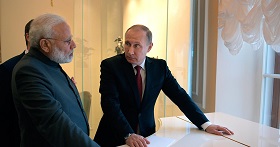
Put the Best Foot Forward: What Russia Could Offer to India
One can also see India putting a premium on its ties with Russia, from the standpoint of Moscow emerging, though by no means on parity, but as a critical-mass bulwark to an overbearing Washington, in multiple sub-regional areas, from the AFPAK theatre to the Middle Eastern vector. The Russia-China axis constitutes a significant pillar, alternatively framing and shaping the potential contours of a futuristic Afghanistan, and in concert with Pakistan, which can bring certainly material, if not game-changing influence to bear, on ultimate transpiring. Hence, it’s a no-brainer that Modi’s New Delhi, which has prioritized its Central Asian foray and recognizes Russian facilitation towards its incorporation within the SCO and its indispensability to achieve longitudinal access deep into Eurasia, circumventing all the way to Europe, cannot but keep Moscow cultivated, in the face of deepening ties with Washington. Russia was no less central to ironing out the creases that led to the P5+1 — Iran arrangement of the JCPOA, in that it had a protagonist-cum-superintendence role to dispose of, in the accord’s sequential and qualitative implementation. With current US-Iran tensions on the boil, Russia could once again emerge the “prima donna conduit” to de-escalation, which beholds dividends for India. Similarly, despite not being an OPEC member, Moscow through its strong links with Iran and a blossoming working relationship with Saudi Arabia, it is a not-so-discreet influence, nudging energy politics, if not dynamics, again with implications for India.
***
Going forward, three quintessential strategic objectives continually permeating Indian foreign policy endeavors and initiatives are the quest for consolidation of its uniquely centripetal role in advancing economic cooperation and functional regionalism goals sub-continent wide, within an increasingly vibrancy sworn South Asia; to substantively and efficaciously integrate adjoining neighbourhoods, both in the East (South East Asia) and to the West (Central and West Asia), through all forms of connectivity accessed mobility, be it hard and/or soft, physical and/or virtual; and to seamlessly integrate within, rather than aggressively impinge upon, the wider global institutions of financial management, regimes at trade facilitation and structures of governance enabling, by clamouring for reforms in architecture and processes, but not quite an upending the order.
(votes: 4, rating: 4.75) |
(4 votes) |
What Kind of Eurasia will Enter the 22nd Century
Heartland Reunion: Geopolitical Chimera or Historical Chance?The Eurasian Heartland of the 21st century is actually what Mackinder saw as the “inner crescent.” Primarily China and India, in relation to which the rest of the Eurasian massif – Russia, Central Asia, Southeast Asia, the Middle East and even the extended European peninsula of the Asian mainland – act as continental limitrophe states
BRICS Should Avoid Becoming an anti-US GroupInterview with Dattesh Parulekar, Assistant Professor, Centre for Latin American & International Studies, Goa University
BRICS, SCO and Kashmir TerrorismThe Role of BRICS and the SCO in Coordinating Anti-Terrorist Activities in South Asia
Put the Best Foot Forward: What Russia Could Offer to IndiaWhat prevents Russia and India from making a breakthrough in bilateral relations?




